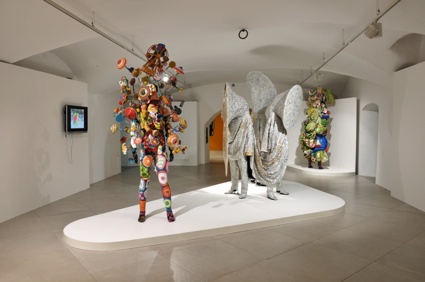 Nick Cave, Various works. Exhibition view at CCC Strozzina. Photo Martino Margheri
Nick Cave, Various works. Exhibition view at CCC Strozzina. Photo Martino Margheri
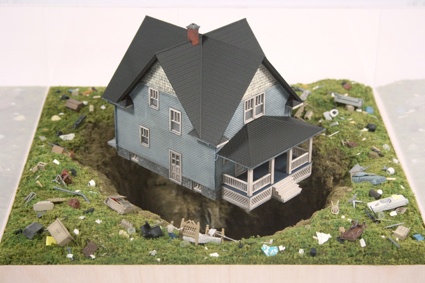 Thomas Doyle, Null Cipher, 2006
Thomas Doyle, Null Cipher, 2006
American Dreamers, the exhibition currently on view at Strozzina, Center for Contemporary Culture at Palazzo Strozzi in Florence, invites us to question what remains of the American dream in this age of weak economy, war on terror and housing crisis.
Does the American dream still exist? What is its future in an era in which the promise of happiness and economic prosperity seems to clash with an increasingly complex and difficult scenario?
America’s sense of invulnerability is long gone and whether they live inside or outside the country, people are now struggling to hold on to the American dream. Recent reports even show that for first time since Depression, more Mexicans leave U.S. than enter.
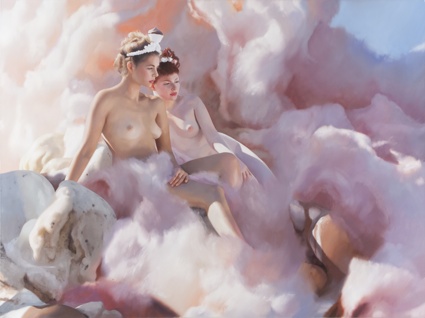 Will Cotton, Consuming Folly, 2009-2010
Will Cotton, Consuming Folly, 2009-2010
How do contemporary artists react and comment on the situation? While many of them have chosen to document the social and economic crisis, others are using it to build a refuge, an alternative world made of fantasy and illusions. This second reality might sometimes present a veneer of nostalgia and hedonism but it always comes with a dark undercurrent. In some cases, the imagined reality steps right into dystopia.
But have no illusions about American Dreamers. There’s nothing ‘exotic’ and distant about it. It also (alas!) holds a mirror to a Europe where social welfare policies are at risk, economic unease is growing in households and market-wide, austerity measures spark protests and far right votes (this morning hit me with worrying stories about Greece and Verona.)
Eleven artists have been invited to show their vision of what is left of the American dream, here’s a quick selection:
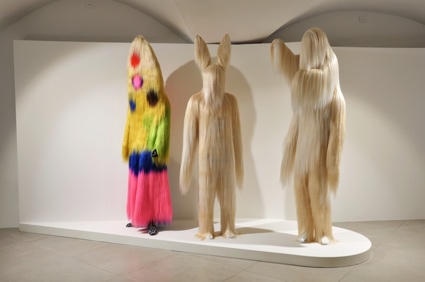 Nick Cave, Soundsuit, 2010 and Mating Season, 2011. Photo Martino Margheri
Nick Cave, Soundsuit, 2010 and Mating Season, 2011. Photo Martino Margheri
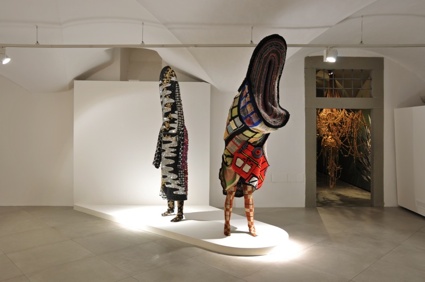 Nick Cave, Soundsuit, 2010 and Soundsuit, 2011. Photo Martino Margheri
Nick Cave, Soundsuit, 2010 and Soundsuit, 2011. Photo Martino Margheri
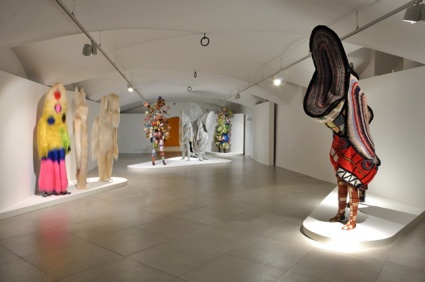 Nick Cave, Various works. Exhibition view at CCC Strozzina. Photo Martino Margheri
Nick Cave, Various works. Exhibition view at CCC Strozzina. Photo Martino Margheri
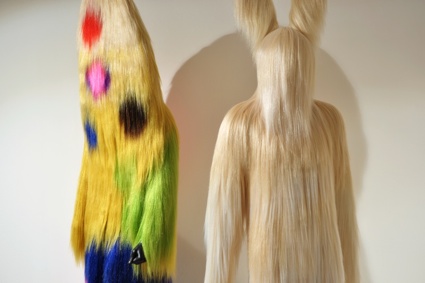 Nick Cave, Soundsuit, 2010 and Mating Season, 2011. Photo Martino Margheri
Nick Cave, Soundsuit, 2010 and Mating Season, 2011. Photo Martino Margheri
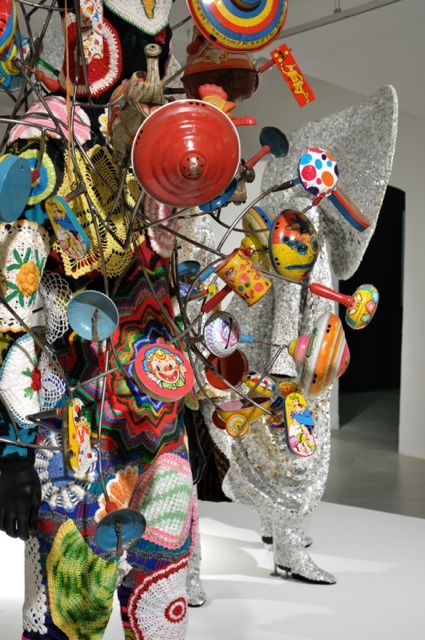 Nick Cave, Soundsuit, 2010. Photo Martino Margheri
Nick Cave, Soundsuit, 2010. Photo Martino Margheri
Soundsuits! Soundsuits! Nick Cave’s wearable sculptures are made of beads, feather, sequins and fabrics found in thrift stores but also discarded fake fur, human hair, twigs, etc. Even children’s toys. When worn by dancers during street or gallery performances, the Soundsuits take a life of their own, shifting volumes, producing different sounds depending on the materials they are made out of.
By physically sheltering the wearer from external gaze, the Soundsuits neutralize their gender, age, race and class. The soundsuits also act as carapaces where wearers can retreat from reality. Moreover, the spectacle they create during public performances projects spectators into an alternate reality.
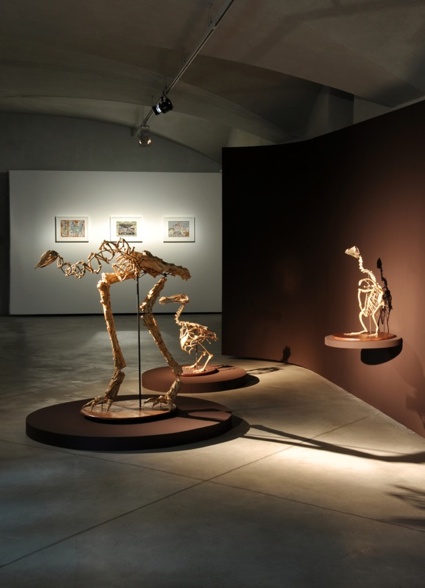 Christy Rupp, Various works. Exhibition view at CCC Strozzina. Photo Martino Margheri
Christy Rupp, Various works. Exhibition view at CCC Strozzina. Photo Martino Margheri
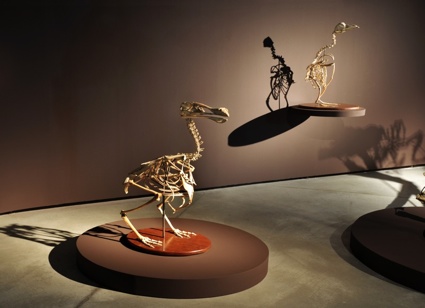 Christy Rupp, Various works. Exhibition view at CCC Strozzina. Photo Martino Margheri
Christy Rupp, Various works. Exhibition view at CCC Strozzina. Photo Martino Margheri
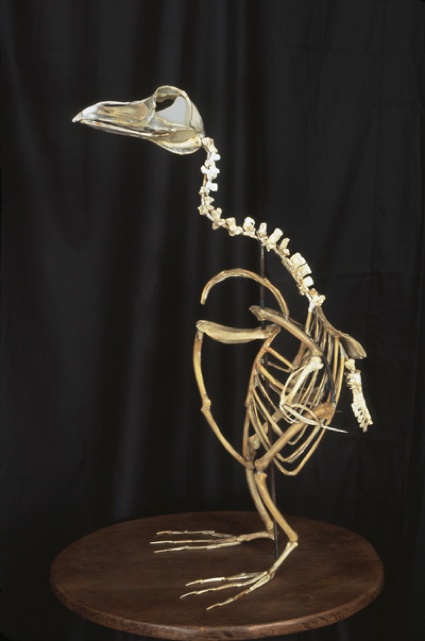 Christy Rupp, Great Auk, from the series Extinct Birds Consumed by Humans, 2005-2008
Christy Rupp, Great Auk, from the series Extinct Birds Consumed by Humans, 2005-2008
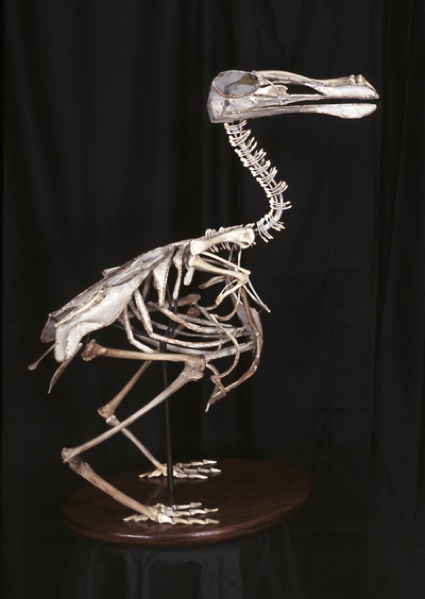 Christy Rupp, Dodo, from the series Extinct Birds Consumed by Humans, 2005-2008
Christy Rupp, Dodo, from the series Extinct Birds Consumed by Humans, 2005-2008
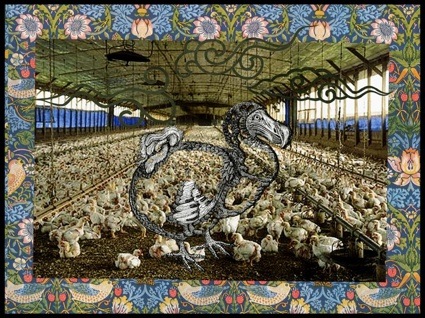 Christy Rupp, Brinkiness, 2007-8
Christy Rupp, Brinkiness, 2007-8
Christy Rupp‘s skeletons of Extinct Birds Previously Consumed by Humans evoke the remains exhibited at museums of natural history, but they are actually made from bone fragments of chicken and turkey that she collected from rubbish bins outside fast-food restaurants and barbecues. The Strozzina shows a Dodo, a Great Auk and a Moa, three flightless birds that were erased from the surface of the earth because of reckless hunting. The bird species consumed in fast food joints might not be extinct but, raised in intensive factory farming, they are nevertheless the victims of man’s greed and disregard for basic animal welfare.
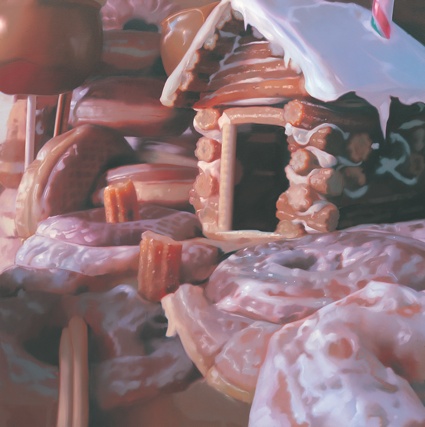 Will Cotton, Abandoned (Churro Cabin), 2002
Will Cotton, Abandoned (Churro Cabin), 2002
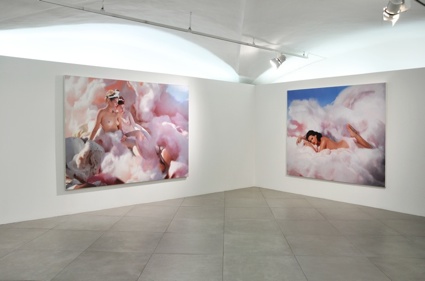 Will Cotton, Various works. Exhibition view at CCC Strozzina. Photo Martino Margheri
Will Cotton, Various works. Exhibition view at CCC Strozzina. Photo Martino Margheri
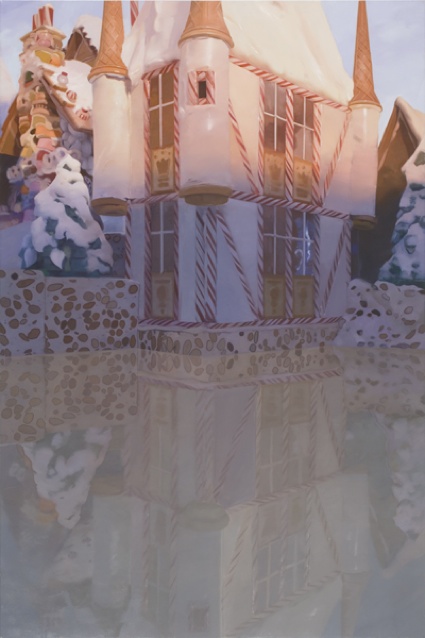 Will Cotton, Various works. Exhibition view at CCC Strozzina. Photo Martino Margheri
Will Cotton, Various works. Exhibition view at CCC Strozzina. Photo Martino Margheri
Will Cotton’s paintings also allude to hyper-consumption but in a cotton candy, cupcakes and all things syrupy way. Drawing inspiration from 18th century French Rococo painters, from Tiepolo and 1950s pinups, his works seem ethereal and insouciant but a closer inspection reveal underlying fears of decadence and over-indulgence. Consummation of Empire, for example, directly points to Thomas Cole’s five-part series The Course of Empire, which even in the 1830s was sounding a warning bell about American imperial ambitions.
Cotton recently worked as Art Director for Katy Perry’s California Gurls, transferring his saccharine painted universe into music video. He certainly has all my admiration for getting Snoop Dogg into that cupcake suit.
Katy Perry, California Gurls ft. Snoop Dogg
Richard Deon looks back at golden-era America with paintings that restage drawings from 1950s civics handbooks.
The main protagonist of the works is a dapper man in a suit. He’s stern, he’s standing tall and keeping his hands at his sides but the nostalgia for a more glorious time stops here. The figure in suit is also submitted to absurd juxtapositions and erroneous perspectives. He is surrounded by mysterious symbols and placed in inadequate settings and historical references.
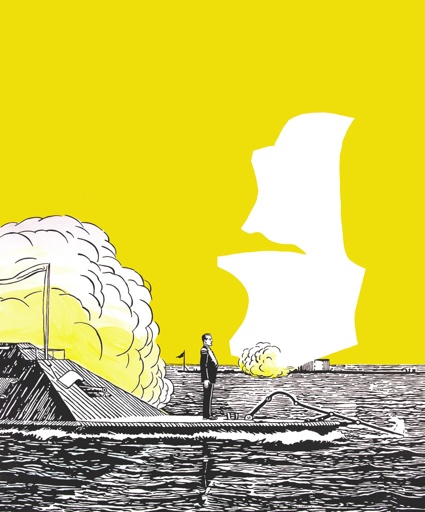 Richard Deon, Weehawken 2, 2008
Richard Deon, Weehawken 2, 2008
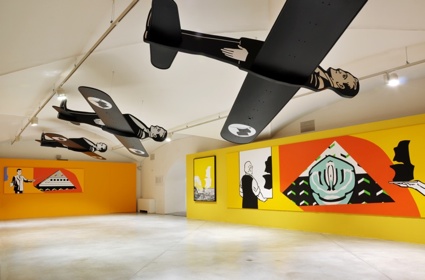 Richard Deon, Various works. Exhibition view at CCC Strozzina. Photo Martino Margheri
Richard Deon, Various works. Exhibition view at CCC Strozzina. Photo Martino Margheri
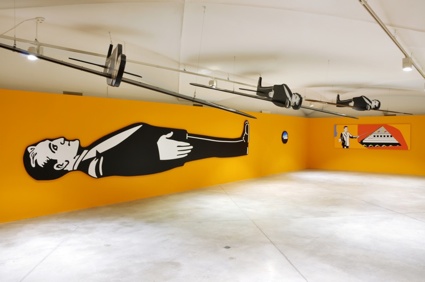 Richard Deon, Various works. Exhibition view at CCC Strozzina. Photo Martino Margheri
Richard Deon, Various works. Exhibition view at CCC Strozzina. Photo Martino Margheri
Home is the center stone of middle-class American culture. They are bigger, more comfortable and immaculate than anywhere else in the world. But in Thomas Doyle‘s sinister settings, there is something worryingly precarious about the American home. Families tend to their garden, chat in the kitchen or come back from grocery shopping without realizing that the whole world around their home is about to crumble.
There’s no clearer metaphor for the real estate bust that is hurting so many householders.
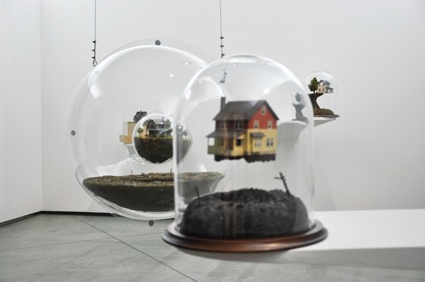 Thomas Doyle, Various works. Exhibition view at CCC Strozzina. Photo Martino Margheri
Thomas Doyle, Various works. Exhibition view at CCC Strozzina. Photo Martino Margheri
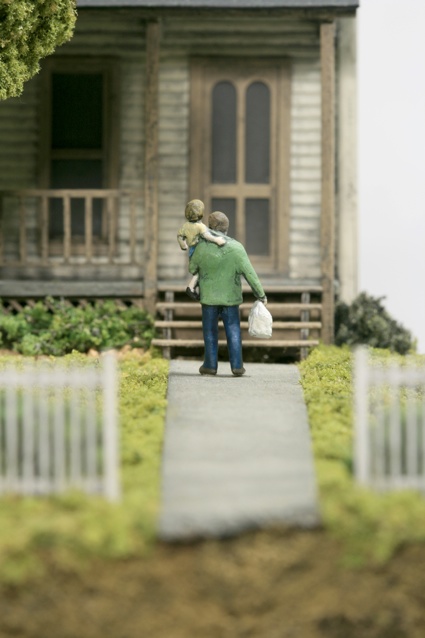 Thomas Doyle, Acceptable losses (detail), 2008
Thomas Doyle, Acceptable losses (detail), 2008
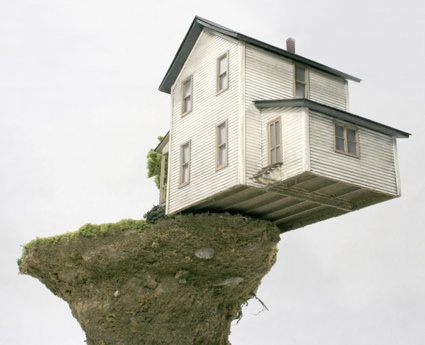 Thomas Doyle, Acceptable Losses, 2008 (detail)
Thomas Doyle, Acceptable Losses, 2008 (detail)
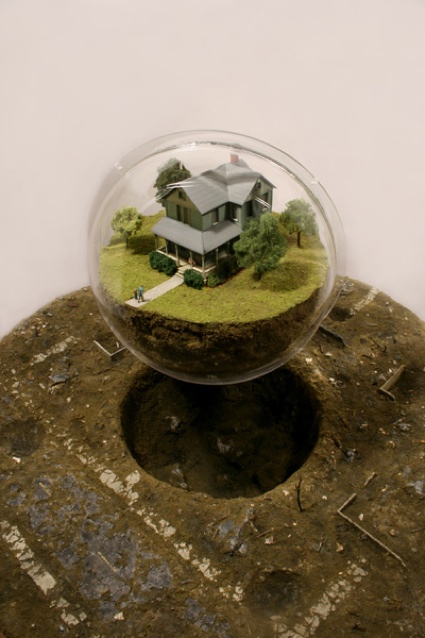 Thomas Doyle, Flying for Effect, 2010
Thomas Doyle, Flying for Effect, 2010
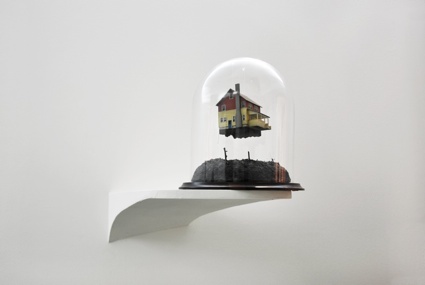 Thomas Doyle. Exhibition view at CCC Strozzina. Photo Martino Margheri
Thomas Doyle. Exhibition view at CCC Strozzina. Photo Martino Margheri
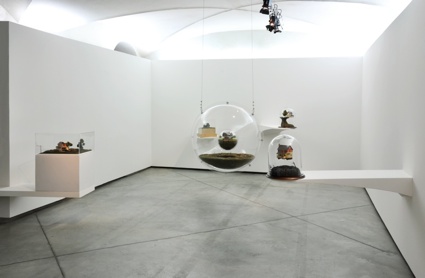 Thomas Doyle, Various works. Exhibition view at CCC Strozzina. Photo Martino Margheri
Thomas Doyle, Various works. Exhibition view at CCC Strozzina. Photo Martino Margheri
I took some photos, they are as awful as ever.
American Dreamers remains open Strozzina, Center for Contemporary Culture at Palazzo Strozzi in Florence until 15 July 2012.
